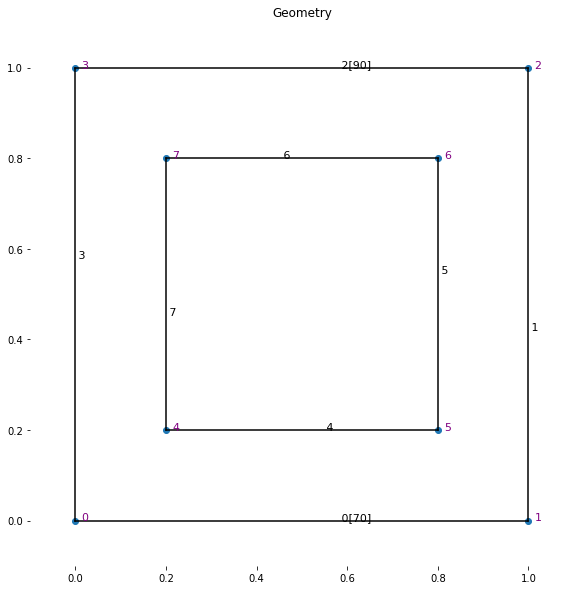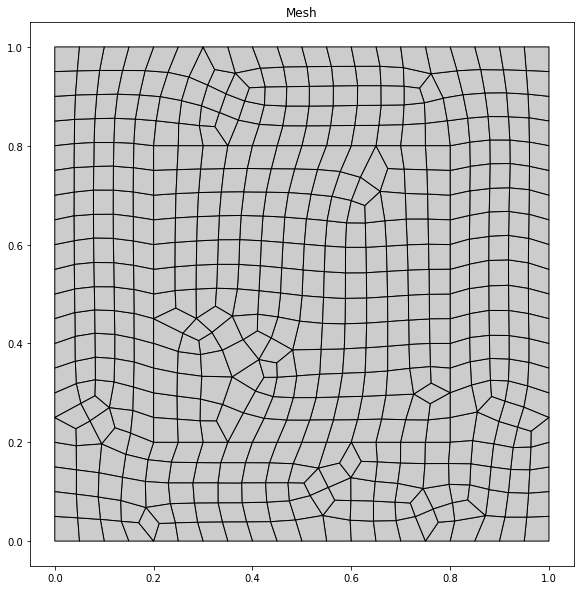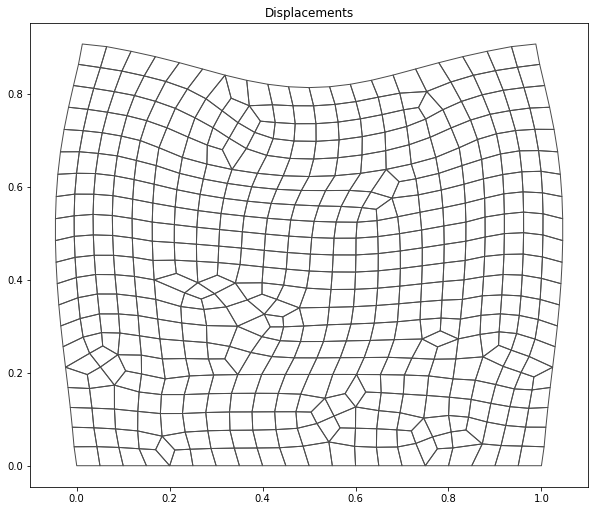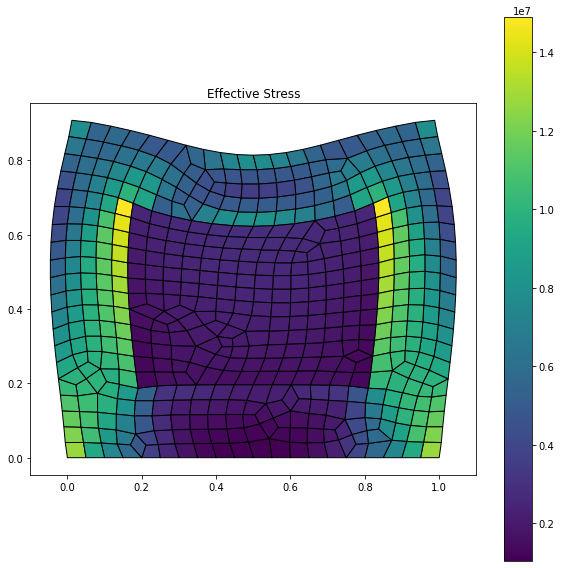Mesh example: Effective stress¶
The use case from the user manual. The example does not contain anything that is not covered in the previous examples.
[1]:
import calfem.core as cfc
import calfem.geometry as cfg
import calfem.mesh as cfm
import calfem.vis_mpl as cfv
import calfem.utils as cfu
import numpy as np
from scipy.sparse import lil_matrix
[2]:
# %matplotlib notebook
%matplotlib inline
Problem parameters
[3]:
t = 0.2
v = 0.35
E1 = 2e9
E2 = 0.2e9
ptype = 1
ep = [ptype,t]
D1 = cfc.hooke(ptype, E1, v)
D2 = cfc.hooke(ptype, E2, v)
# Define marker constants instead of using numbers in the code
mark_E1 = 55
mark_E2 = 66
mark_fixed = 70
mark_load = 90
# Create dictionary for the different element properties
elprop = {}
elprop[mark_E1] = [ep, D1]
elprop[mark_E2] = [ep, D2]
# Parameters controlling mesh
el_size_factor = 0.05 # Element size factor
el_type = 3 # Triangle element
dofs_per_node = 2 # Dof per node
Create geometry
[4]:
g = cfg.Geometry()
Add points
[5]:
g.point([0, 0]) #0
g.point([1, 0]) #1
g.point([1, 1]) #2
g.point([0, 1]) #3
g.point([0.2, 0.2]) #4
g.point([0.8, 0.2]) #5
g.point([0.8, 0.8]) #6
g.point([0.2, 0.8]) #7
Add curves
[6]:
g.spline([0, 1], marker = mark_fixed) #0
g.spline([2, 1]) #1
g.spline([3, 2], marker = mark_load) #2
g.spline([0, 3]) #3
g.spline([4, 5]) #4
g.spline([5, 6]) #5
g.spline([6, 7]) #6
g.spline([7, 4]) #7
Add surfaces
[7]:
g.surface([0,1,2,3], holes = [[4,5,6,7]], marker = mark_E1)
g.surface([4,5,6,7], marker = mark_E2)
Create mesh
[8]:
mesh = cfm.GmshMeshGenerator(g)
mesh.el_size_factor = el_size_factor
mesh.el_type = el_type
mesh.dofs_per_node = dofs_per_node
# Mesh the geometry:
# The first four return values are the same as those that trimesh2d() returns.
# value elementmarkers is a list of markers, and is used for finding the
# marker of a given element (index).
coords, edof, dofs, bdofs, elementmarkers = mesh.create()
Info : GMSH -> Python-module
Solve problem
Assemble system
[9]:
nDofs = np.size(dofs)
K = lil_matrix((nDofs,nDofs))
ex, ey = cfc.coordxtr(edof, coords, dofs)
for eltopo, elx, ely, elMarker in zip(edof, ex, ey, elementmarkers):
if el_type == 2:
Ke = cfc.plante(elx, ely, elprop[elMarker][0], elprop[elMarker][1])
else:
Ke = cfc.planqe(elx, ely, elprop[elMarker][0], elprop[elMarker][1])
cfc.assem(eltopo, K, Ke)
Solve equation system
[10]:
bc = np.array([],'i')
bcVal = np.array([],'i')
bc, bcVal = cfu.applybc(bdofs, bc, bcVal, mark_fixed, 0.0)
f = np.zeros([nDofs,1])
cfu.applyforcetotal(bdofs, f, mark_load, value = -10e5, dimension=2)
a,r = cfc.spsolveq(K, f, bc, bcVal)
Calculate element forces
[11]:
ed = cfc.extract_eldisp(edof, a)
von_mises = []
for i in range(edof.shape[0]):
# Handle triangle elements
if el_type == 2:
es, et = cfc.plants(ex[i,:], ey[i,:],
elprop[elementmarkers[i]][0],
elprop[elementmarkers[i]][1],
ed[i,:])
von_mises.append( np.math.sqrt( pow(es[0,0],2) - es[0,0]*es[0,1] + pow(es[0,1],2) + 3*pow(es[0,2],2) ) )
else:
# Handle quad elements
es, et = cfc.planqs(ex[i,:], ey[i,:],
elprop[elementmarkers[i]][0],
elprop[elementmarkers[i]][1],
ed[i,:])
von_mises.append( np.math.sqrt( pow(es[0],2) - es[0]*es[1] + pow(es[1],2) + 3*pow(es[2],2) ) )
Visualise results
Geometry
[12]:
cfv.figure(fig_size=(10,10))
cfv.draw_geometry(g, title="Geometry")

Mesh
[13]:
cfv.figure(fig_size=(10,10))
cfv.draw_mesh(coords=coords, edof=edof, dofs_per_node=dofs_per_node, el_type=el_type,
filled=True, title="Mesh") #Draws the mesh.

Displacements
[14]:
cfv.figure(fig_size=(10,10))
cfv.draw_displacements(a, coords, edof, dofs_per_node, el_type,
draw_undisplaced_mesh=False, title="Displacements",
magnfac=25.0)

Element values
[15]:
cfv.figure(fig_size=(10,10))
cfv.draw_element_values(von_mises, coords, edof, dofs_per_node, el_type, a,
draw_elements=True, draw_undisplaced_mesh=False,
title="Effective Stress", magnfac=25.0)
cfv.colorbar()
[15]:
<matplotlib.colorbar.Colorbar at 0x7f65c86de5f8>

[ ]: